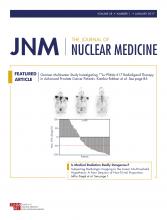TO THE EDITOR: We read with interest the article by Janssen et al. (1) that analyzed the clinical utility of 68Ga-DOTATATE PET/CT in the detection of head and neck paragangliomas (HNPGLs) compared with anatomic imaging using CT/MRI and with other functional imaging modalities, including 18F-fluorohydroyphenylalanine (18F-FDOPA) PET/CT, 18F-FDG PET/CT, and 18F-fluorodopamine PET/CT.
In this study, 68Ga-DOTATATE PET/CT was able to detect more lesions (38/38) than any other imaging modality, with only 23 lesions being identified by CT/MRI (P < 0.01). On the basis of those results, the authors concluded that 68Ga-DOTATATE PET/CT may become the preferred functional imaging modality for HNPGLs. Although 68Ga-DOTATATE PET/CT seems a more efficient imaging modality than 18F-FDOPA PET/CT, 18F-FDG PET/CT, or 18F-fluorodopamine PET/CT, we believe that the comparison with MRI is not valid.
First, the MRI protocol used in the study of Janssen et al. was suboptimal because of the lack of contrast-enhanced angio-MRI (CE-MRA) covering the head and neck area. CE-MRA is known to be the key sequence for the detection of HNPGLs (2–4) and is now broadly used in radiology departments. Paragangliomas are highly vascularized tumors, and the arterial enhancement of HNPGLs highlighted by CE-MRA, in combination with localization of the lesion, makes MRI—unlike what the authors state—a highly specific imaging modality, with specificity exceeding 94% (2–4). Furthermore, detection rates of MRI in the study are not consistent with the current literature, because sensitivity and specificity reach 90% or more with a proper MRI protocol (2–4).
Second, CT and MRI were evaluated together as a single imaging modality even though 3 patients did not undergo head and neck MRI. This may have biased the results by underestimating the detection rates of CT/MRI, because MRI has long been known to be superior to CT for the detection of HNPGLs (5).
The authors also state that 68Ga-DOTATATE PET/CT, unlike MRI, provides the advantage of whole-body imaging. Yet, whole-body MRI is feasible and is currently recommended by the Endocrine Society and by the European Society of Endocrinology for the follow-up of genetically predisposed patients (6–8).
To our knowledge, only one study showed a higher detection rate for 68Ga-DOTATATE PET/CT than for a proper MRI protocol that included CE-MRA (9).
We acknowledge that 68Ga-DOTATATE PET/CT is a promising imaging modality for the detection of HNPGLs. However, the superiority of 68Ga-DOTATATE PET/CT over MRI cannot be asserted by this study and should be confirmed by further studies comparing 68Ga-DOTATATE PET/CT with an appropriate MRI protocol including CE-MRA.
Footnotes
Published online Jul. 21, 2016.
- © 2017 by the Society of Nuclear Medicine and Molecular Imaging.







